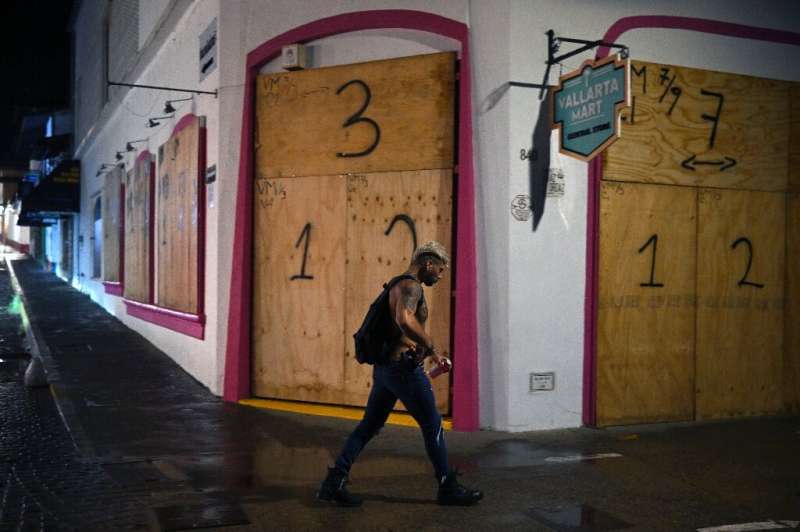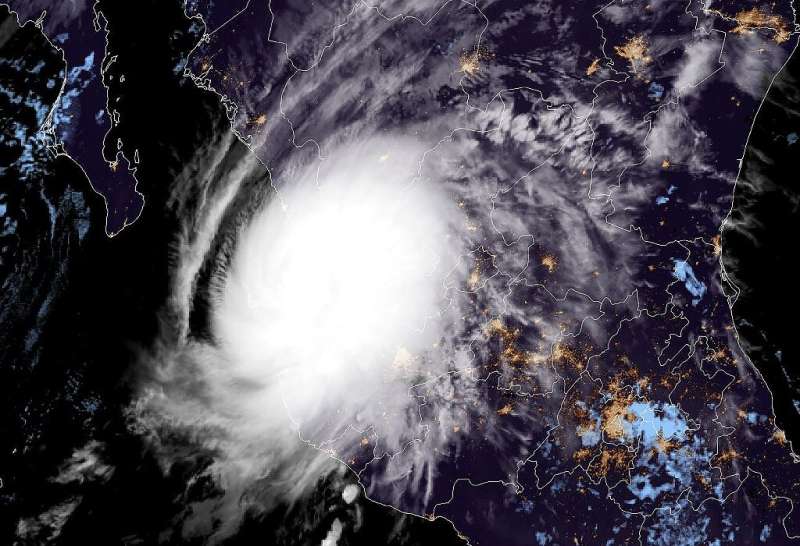Businesses in the tourist area of Puerto Vallarta in Jalisco state, Mexico, boarded up shopfronts in preparation for Hurricane Roslyn's landfall.
Hurricane Roslyn made landfall on the west coast of Mexico on Sunday as a powerful Category 3 storm, the US National Hurricane Center said, as communities sheltered from damaging winds, a dangerous storm surge and flash flooding.
The storm hit near the small town of Santa Cruz in the coastal Nayarit state around 5:30 am (1130 GMT) packing estimated maximum sustained winds of 120 miles (195 kilometers) per hour, the NHC said.
Just hours before hitting the Mexican shore, Roslyn was downgraded from a Category 4 to a Category 3 storm on the five-tier Saffir-Simpson Wind Scale, with the NHC predicting "rapid weakening" after landfall.
The NHC and the Mexico meteorological service warned of damaging winds, heavy rains that could cause flash flooding and landslides and waves up to six meters (20 feet) high along the Pacific coast.
"Roslyn is expected to produce a life-threatening storm surge with significant coastal flooding in areas of onshore winds" through Sunday, the NHC said, adding that near the coast "the surge will be accompanied by large and destructive waves."
Authorities issued hurricane warnings for portions of the Pacific coast states of Jalisco, Nayarit, Sinaloa and Las Islas Marias, some 60 miles offshore.
High winds and rough seas hit the Jalisco resort of Puerto Vallarta, home to some 220,000 people and one of the largest towns in the area affected by the hurricane, around 0900 GMT.
In the Nayarit town of Bucerias, the downpour turned some roads into rivers.
Residents were on high alert after Roslyn, the most powerful storm so far of the Pacific season, reached Category 4 after forming on Friday before it was downgraded.
Hurricane Roslyn was downgraded to a Category 3 storm before it made landfall on Mexico's Pacific coast.
'Heed every warning'
Jalisco, which is slated to get up to 10 inches (25 centimeters) of rain in some spots, set up shelters in the cities of Cabo Corrientes, La Huerta and Puerto Vallarta.
Victor Hugo Roldan, director of civil protection in Jalisco, told reporters on Saturday that several hundred people had been evacuated from the town of La Huerta, close to the hurricane's expected path.
Most went to relatives' homes, while some went to shelters, he said.
Businesses in the resort town began to close Saturday afternoon on officials' recommendations.
Residents rushed to make last-minute preparations, though by late Saturday afternoon some tourists were still lounging on the beach or unsuccessfully searching for open bars and restaurants.
For 59-year-old shopping mall manager Graciano Pena, the memory of 2002's Hurricane Kenna, which made landfall as a damaging Category 4 and left four dead, is still fresh.
"After that experience, we heed every warning and make preparations ahead of time," he said.
Other coastal states also prepared shelters.
Tropical cyclones hit Mexico every year on both its Pacific and Atlantic coasts, usually between May and November.
At the end of May, Agatha, the first Pacific storm of the season, hit the coast of the southern state of Oaxaca, where heavy rain in mountainous towns killed 11 people.
In October 1997, Hurricane Pauline struck Mexico's Pacific coast as a Category 4 storm, leaving more than 200 dead.
© 2022 AFP

























